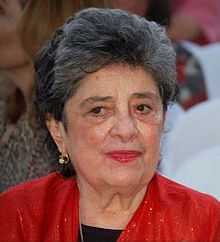Claribel Alegría
| Clara Isabel Alegría Vides | |
|---|---|
 Alegría at the 3rd annual International Poetry Festival in Granada. | |
| Born |
May 12, 1924 Estelí, Nicaragua |
| Pen name | Claribel Alegría |
| Occupation | Poet, Novelist |
| Nationality |
|
Clara Isabel Alegría Vides[1] (born May 12, 1924) is a Nicaraguan poet, essayist, novelist, and journalist who is a major voice in the literature of contemporary Central America. She writes under the pseudonym Claribel Alegría.[2] She was awarded the 2006 Neustadt International Prize for Literature.
Early life
Alegría was born in Estelí, Nicaragua and grew up in the Santa Ana area in western El Salvador. In 1943, she moved to the United States and in 1948 received a B.A. in Philosophy and Letters from George Washington University.[3] Alegría was committed to nonviolent resistance. She had a close association with the Sandinista National Liberation Front (FSLN), which overthrew Anastasio Somoza Debayle and took control of the Nicaraguan government in 1979. Alegría returned to Nicaragua in 1985 to aid in the reconstruction of Nicaragua.[4]
Alegría now lives in Managua, Nicaragua.[3]
Career
Alegría's works of literature reflect the style of the popular literary current in Central America during the 1950s and 1960s, "la generacion comprometida" (the committed generation). Her works follow the practice of several poets of her generation who are critical of their societies and make claims for rights using a language which is often counter-literary. Alegría has published many books of poetry: Casting Off (2003), Sorrow (1999), Umbrales (1996), Fuga de Canto Grande (1992) and La Mujer del Río (1989).
Alegría has published novels and children's stories.
Awards
- 1978 Cuban-sponsored Casa de las Américas for Sobrevivo ("I Survive"), a poetry collection. She was awarded this prize alongside Gioconda Belli.
- 2006 Neustadt International Prize for Literature.[5][6][7]
Published works
|
|
Further reading
- McGowan, Marcia P.; Boschetto-Sandoval, Sandra M. (1994). Claribel Alegria and Central American literature: critical essays. Athens: Ohio University Center for International Studies. ISBN 0-89680-179-9.
References
- ↑ "Claribel Alegría - 1924". Escritoras de Hispanoamerica. Retrieved 2007-10-24.
- ↑ "Claribel Alegría". Encyclopædia Britannica. Retrieved 2007-10-24.
- ↑ 3.0 3.1 "Claribel Alegría bio". World Literature Today (University of Oklahoma). Retrieved 2007-10-24.
- ↑ http://www.poets.org/poet.php/prmPID/275
- ↑ Bunmi Ishola (September 30, 2006). "Claribel Alegría wins Neustadt Prize". The Norman Transcript. Retrieved November 2, 2013.
- ↑ Staff writer (May 1, 2007). "Claribel Alegria: 2006 Neustadt International Prize Laureate.(special section)(Biography)". World Literature Today. Retrieved November 2, 2013.
- ↑ "Neustadt Prize". The Missouri Review. November 16, 2006. Retrieved November 2, 2013.
Further reading
- McGowan, Marcia Phillips (1999). "Alegría Claribel". In Commire, Anne. Women in World History: A biographical encyclopedia 1. Waterford, CT: Yorkin Publications, Gale Group. pp. 193–198. ISBN 0787640808.
External links
- (Spanish) Claribel Alegría gana premio internacional
- (Spanish) Encuentro-Taller con Claribel Alegría
- (Spanish) Academy of American Poets
- (Spanish) Claribel Alegria at Curbstone Press
|